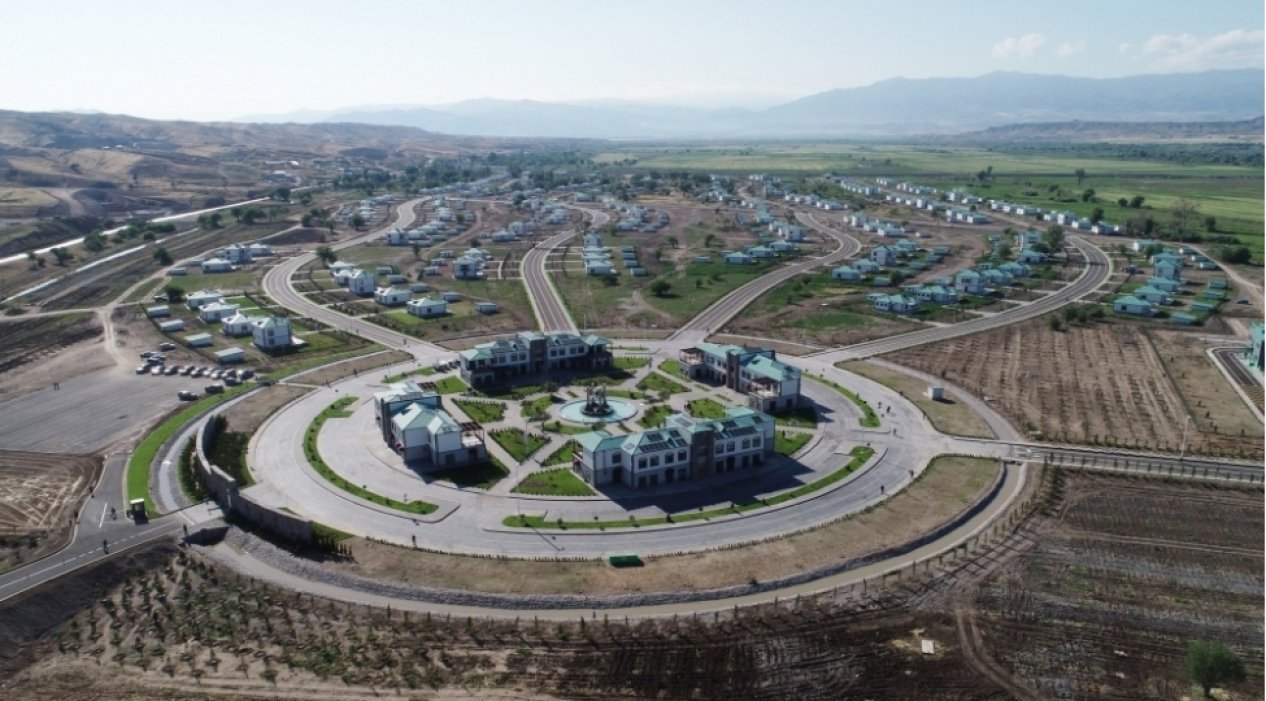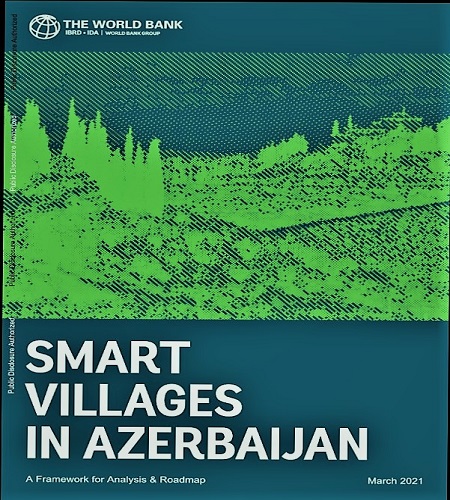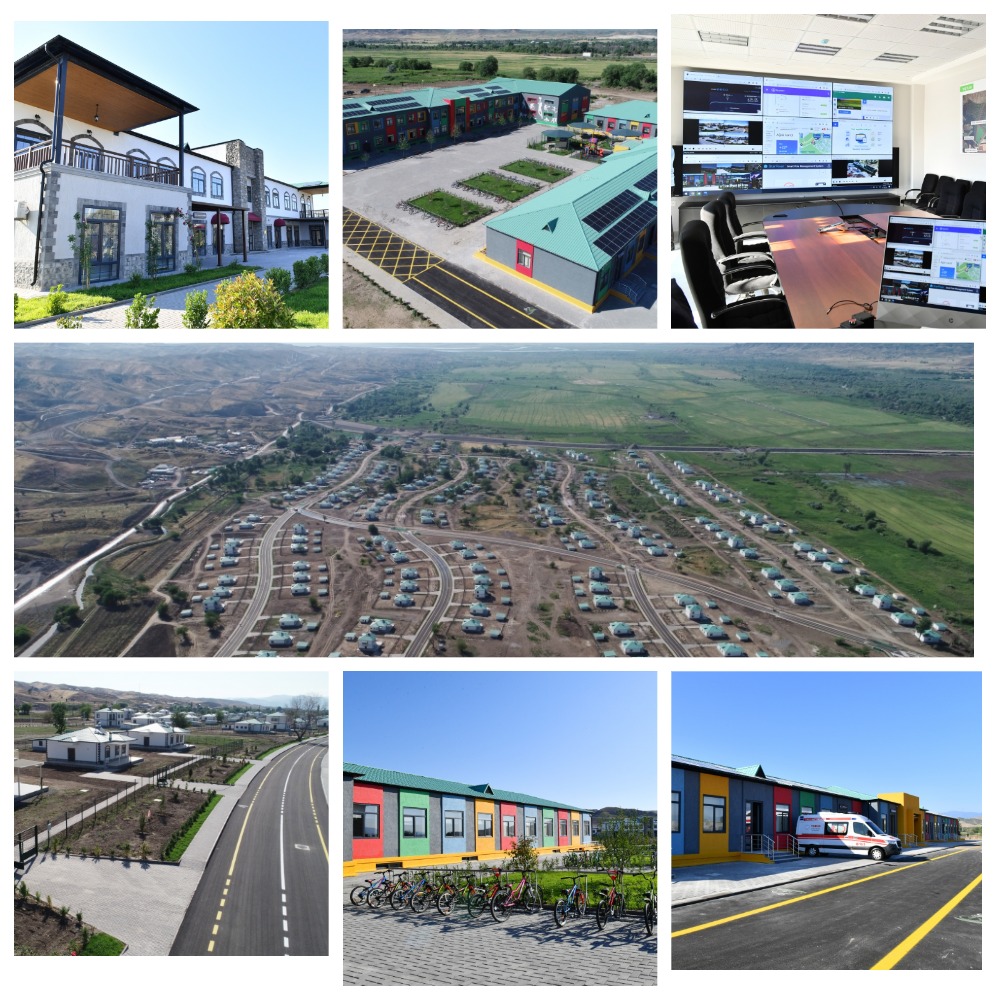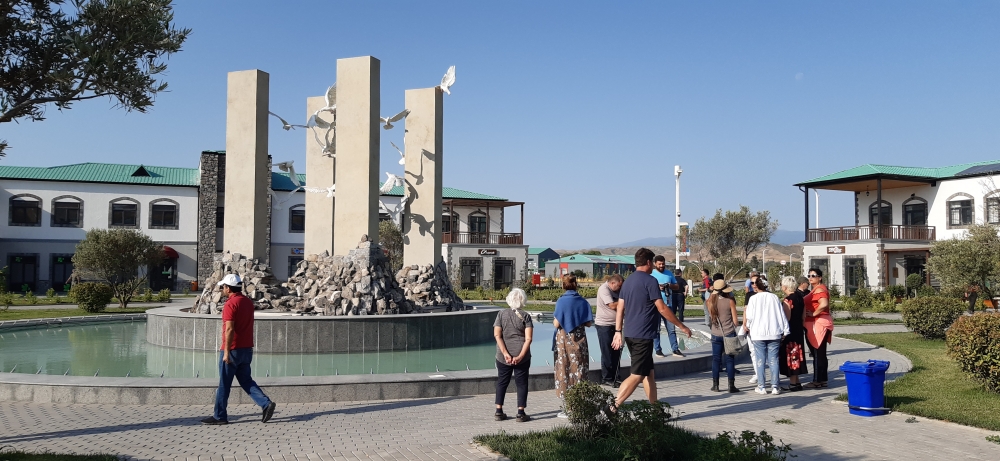
In March 2021, the World Bank (WB) published an article on the analysis of existing resources and the potential for the implementation of the "smart village" model in Azerbaijan. For some reason, Radio Liberty (RFE/RL) broadcast this report in June, with different photos and headlines, highlighting only the critical parts. In June of 2022, the first phase of the "smart village" project was completed, and the results of the first phase are visible.
Faktyokla Lab has conducted a comparative analysis of the World Bank research and the unique interpretations of RFE/RL.

The document draws attention to the fact that the population is more rural in Azerbaijan than in neighboring countries. It emphasized that 47 percent of the people in Azerbaijan are rural residents. This indicator is close to the world average (49 percent). Among other countries of the South Caucasus, 42 percent of the population in Georgia and 37 percent in Armenia live in villages.
It is clear that the reason for the large influx to the city, that is, the smaller number of rural residents, is the availability of more opportunities to earn income in the city. Because cities are large industrial and commercial centers, the demand for goods and services is much higher here than in the countryside. This, without a doubt, leads to superior income opportunities in the city. People do not find work and normal livelihood in the village, so they go to the capital or big cities.
Now let's pay attention, 47 percent of the population in Azerbaijan lives in villages, 53 percent in cities; in Armenia and Georgia, 63 percent and 56 percent of the population live in cities, respectively. This means that the main reason for the concentration of the population in cities in Armenia and Georgia is the difficult economic and social situation, so people move from the countryside to the city. In Azerbaijan, the ratio of rural and urban populations is almost the same, which indicates equal economic and social living standards. That is, households in the capital and regions have socio-economic balance and equal living opportunities. According to the research carried out by the State Statistics Committee of Azerbaijan on households, a year ago, the average monthly salary of employees in Baku was 927.8 manats, while the average figure for different economic regions was 480-550 manats. For example, in the Nakhchivan Autonomous Republic this number was 535 manats, in Absheron-Khizi economic region 582, in Ganja-Dashkasan 505, in Central Aran 440, in Eastern Zangezur 501, in Shirvan-Salyan economic region 518 manats. (Source)
This means that there is a difference of about 60 percent between the wages of workers in the capital and people working in the regions. However, the comparison of consumption costs and purchasing parity in rural and urban areas eliminates that difference. Because in terms of consumption expenses, the monthly expenses of those who live in villages are 2 times lower than in cities. Based on the parity of consumption costs, the budget of 500 manats in rural regions is equal to 800 manats in the capital according to purchasing power.
It should not be forgotten that the unequal income distribution between the capital and regions is still relevant today as one of the main laws of classical economics. Even today, income inequality is based on the Lorenz curve and the Gini index. From this point of view, there are 80 percent (sometimes 2-3 times) differences in incomes between capitals and large cities and rural regions in all countries. (Source).
The ratio of incomes in different cities and regions is the same in the countries of the European Union, Germany, France, Norway, Italy and other countries, the central development pole of the region.

The authors of the WB report, hiding the true socio-economic picture of other countries in the South Caucasus, claim that there are still threats of poverty for rural residents in Azerbaijan. Allegedly, more than 60 percent of the poor population lives in villages. In general, 57 percent of the people living in rural areas are at risk of poverty.

Let's note that for Azerbaijan, 57 percent means 3.5 million people. Today, the number of the economically active population in the country is more than 5.3 million people, and about 5 million of them are employed. (Source)
Only 2 million people of that employed population work in agriculture. That is, 2 million of the 6 million people in the regions are directly connected to agriculture and earn income. Besides, tens of thousands of people work in processing, tourism, and other fields in villages and regions. The number of teachers, doctors, police, as well as the employees of the law enforcement, judicial, administration, economic structures and other state organizations in the regions is close to 400,000. More than 700,000 pensioners and benefit recipients are rural residents. Thus, their total number exceeds 3.5 million people. The report's authors calculate that none of those 3.5 million people living in rural areas are working and have no income, and thus claim that they are at risk of poverty?
According to the UN methodology, people with a daily income of less than $3.2 are considered poor. In Azerbaijan, the number of people with this amount of income ($96 * 1.7 AZN = 163 AZN) is equal to 5-6 percent.
As we emphasized above, the ratio of the total average monthly income of people living in the regions - state organizations, private sector and pensioners is equal to 450-500 manats. Also, more than 110,000 families receive targeted social assistance in Azerbaijan, most of which cover the regions; approximately 80,000-90,000 families receive assistance in the regions, which means more than 400,000 people.
Also, tens of thousands of families were involved in the self-employment program and were covered by the state's financial support.
The subsistence minimum in Azerbaijan is currently 210 manats, which is equal to $123. In addition, the minimum wage in Azerbaijan is 300 manats, and the amount of targeted social assistance given to low-income families, the most vulnerable social group, is 334 manats.
Thus, the average monthly income of people living in rural areas is 400-500 manats, and the lowest income of the most vulnerable social groups is equal to the subsistence minimum, i.e., 210 manats. All this reduces the claims put forward as a poverty risk indicator (163 manats) to zero.
By the way, these days, in the UN's "Sustainable Development-2022" report, Azerbaijan scored 73.5 points out of a possible 100 and was ranked among the best countries in terms of social indicators in the Sustainable Development Goals Index. The average indicator of the Sustainable Development Goals index in Azerbaijan, ranked 50th among 163 countries, was 71.6. Sustainable Development Goals include poverty reduction, clean water supply and health services, sustainable production and consumption levels, quality education, equality of sustainable urban and rural communities and other indicators. (Source)
Thus, the report of the UN, with its important social and economic significance, completely negates the research conducted by the World Bank team, and confirms that it is an example of non-objective amateur work that serves personal interests.

The report also notes that there is inequality in people's access to economic opportunities and social services in rural areas. Today, the regions are the main center of gravity of those engaged in economic activity in Azerbaijan. A total of 27.9 percent of over 1,195,000 individual entrepreneurs operating in Azerbaijan work in Baku, and the remaining entrepreneurs are in regions (10 percent in Lankaran-Astara, 7.6 percent in Gazakh-Tovuz, 6.6 percent in Central Aran and other economic regions). That is, the share of economic regions in the distribution of business entities is more than 70 percent.
Also, only 0.7% of concessional loans given to entrepreneurs by the Entrepreneurship Development Fund with the direct financial support of the state go to the city of Baku, and 99.3% to the regions. According to the amount, 0.3% of loans were given to entrepreneurs operating in Baku city, 99.7% in other regions.
This fact also confirms that the economic opportunities in the regions are more expansive and the state financial support is exceptionally higher.
Let's pay attention to the notes of the report's authors about the limited access to financial resources of rural residents. 92.8% of the concessional loans provided by the Entrepreneurship Development Fund directly involve the production of agricultural products, which includes representatives of the agrarian sector operating in the regions.
In addition, the Agrarian Credit and Development Agency, the Small and Medium Business Development Agency provide loans to the rural population within the framework of various projects. Every year more than 900 million manats are allocated from the budget to agriculture, the final destination of which is the farmers.
The amount of financial resources directed to agriculture in Azerbaijan alone is greater than the amount of resources allocated to the economic sphere by Georgia and Armenia together.
In the 2022 state budget, 997.3 million manats have been allocated to agriculture, of which 477.5 million manats are direct agricultural measures, and half of those funds are subsidies to farmers. (Citizen's Budget Guide. Page 41.).
The official report of the World Bank itself refutes the claims of the authors of this report that citizens have limited access to services in rural areas. Thus, in the "Doing Business 2020" report published by the World Bank 2 years ago, it highly valued the progress achieved in the indicators of business accessibility, availability of economic opportunities, protection of investors' rights and interests, as well as access to services in Azerbaijan. In addition to the capital, the Bank appreciates the significant results in the regions on indicators such as the access of small businesses and people to services, electricity supply and communal services, property registration, and the execution of contracts.
If access to economic and social services was limited, could the ranking of Azerbaijan in the official international report of the World Bank Group be highly valued?
The views in the report questioning the transparency in the provision of subsidies can also be considered as an approach far from objectivity. Thus, the provision of subsidies in Azerbaijan has become fully digital, and according to the decree of the head of state, "On the creation of a new subsidy mechanism in the agricultural sector," from 2020, subsidies are delivered to farmers through a single mechanism. Farmers register in the Electronic Agricultural Information System and post the necessary information about land area, crops and activities in order to receive subsidies. The entire process is regulated electronically by the Agrarian Subsidy Council, and the list of people receiving subsidies, the amount and other information is formalized on the Electronic Government Portal.
On the portal, information about the granting of subsidies is sent to the personal cabinet of farmers, after which they are provided with a "Farmer card", subsidies are transferred to those plastic cards, which are considered bank accounts. Here, the contact of any official is zero, the process is carried out in a completely transparent environment, and everything from "A" to "Z" is electronic. In such a case, is there any point or situation that raises doubts about transparency that the WB makes recommendations?
Another point in the report is related to the level of provision of communal services. It is noted that although the supply of drinking water and heating system in Baku and Absheron is close to the maximum, the situation in rural areas is different. Only 76 percent of rural households have access to drinking water and 82 percent to natural gas.
These numbers are incorrect. The level of gasification in Azerbaijan is close to 97 percent, of course, excluding the territories liberated from occupation. The number of subscribers by population group in the country is more than 2.4 million. This is one of the highest indicators worldwide. In this case, where does the "82 percent" figure come from, and how is it calculated?
When it comes to water supply, water scarcity is currently one of the number one problems in the entire world. The UN and the G20 countries are constantly raising the issue of water shortages at climate summits, and are looking for solutions. (Source)
Let's not forget that one of the main reasons for the water shortage in Azerbaijan was Armenia's usurpation of Azerbaijani water resources in the territories Yerevan occupied for 30 years. However, after the liberation of its territories, Azerbaijan also took ownership of its water resources, in Sugovushan, in the Khachinchay reservoir at the foot of Farrukh mountain, and other water resources in Karabakh and East-Zangezur will play a special role in the water supply of about 20 regions. In addition, the Hakarichay reservoir project, which President Ilham Aliyev viewed during his visit to the Lachin district on June 27, will provide water to 7 districts located in a relatively high geographical area with a capacity of 90 million cubic meters of water. As a result of the commissioning of the project, it will be possible to provide drinking water to about 3 million people. (Source)
This means 30 percent of the country's population and 60 percent of the rural population. Therefore, the main obstacle in Azerbaijan's water shortage was the aggressor Armenia, and the water problem is gradually disappearing. Unfortunately, the members of the mentioned WB reporting team did not have the courage to admit the "water genocide" committed by Armenia against Azerbaijan.
The report states that there are problems related to the speed and level of provision of the internet in the regions of Azerbaijan, because of this, people in the regions have limited opportunities to use social media. Please note: in 2021, when the WB presented the research, 81.1 percent (8.26 million) of the population in Azerbaijan were internet users, and now this figure has reached 85 percent. Last year, the number of internet users increased by 202,000 people, or 2.5 percent, compared to the previous year. Also, the opinion of the respondents who took part in the survey about the activity of internet users using social network platforms confirms that they are highly active in social networks. Also, 91.4 percent of participants use social networks several times a day. (Source)
According to the authors of the World Bank report, the establishment of ASAN Service centers is an important step in terms of simplifying the services provided to citizens. However, rural residents face certain obstacles to using these services. "These barriers are mainly due to the lack of digitization of many services. Many government services still require written applications from citizens and entrepreneurs to issue licenses and permits."
We explain: In accordance with the Decree No. 650 of the President of the Republic of Azerbaijan dated October 19, 2015, "On reducing the number of types of entrepreneurial activity requiring special consent (license), simplifying and ensuring transparency of licensing procedures", except for cases arising from state security, the Ministry of Economy, licenses are issued through "ASAN service" centers. In "Asan service" centers, paper carriers and clerical work are generally not used, and all operations are electronic. In such a case, what kind of written application can be required from the rural population? (Source)
Another comment from the WB experts who have become masters in giving virtual opinions is related to health services. The researchers have revealed that the level of health care in the villages of Azerbaijan is not that high. Medical services provided here are limited to primary care and vaccinations.
Over the past 17 years, more than 750 hospitals have been either rebuilt or fundamentally renovated within the framework of the State Programs for the socio-economic development of the regions. Hundreds of medical centers have been restored in the provinces.
As for rural health care consisting of primary health care, the profile of medical institutions in remote villages in all countries of the world is calculated to provide only primary health care services. In which country does a rural medical center have inpatient services, surgery, CT, and other special high-end health care equipment? After all, health centers in all rural regions are based on ordinary medical services, and higher health services are provided in towns and district central hospitals.
Conclusion:
♦ Since the research group prepared the report document directly based on the opinions of the rural population living in the regions, it made serious distortions and gross errors.
♦ In international practice, any research is based on the documents and social sources provided by the relevant institutions of that country, along with the population, and it is surprising that a reputable institution like the World Bank conducts such research based on one-sided and individual reflections.
None of the members of the team that prepared the report were familiar with the statistical-analytical materials published by the Government of Azerbaijan, including the Economy Ministry, the Ministry of Labor and Social Protection of the Population, the State Statistics Committee, or the organizations conducting research in economic and social fields in Azerbaijan.
♦ Indicators of social development in the regions, criteria measuring the standard of living and other indicators were prepared without reference to statistics, without taking into account the existing databases of the Government of Azerbaijan.
♦ Thus, the report of the World Bank analyzing the available resources and potential of the Azerbaijani countryside is completely far from reflecting the regional development picture of Azerbaijan, as it is based on contradictory and non-objective studies.


















